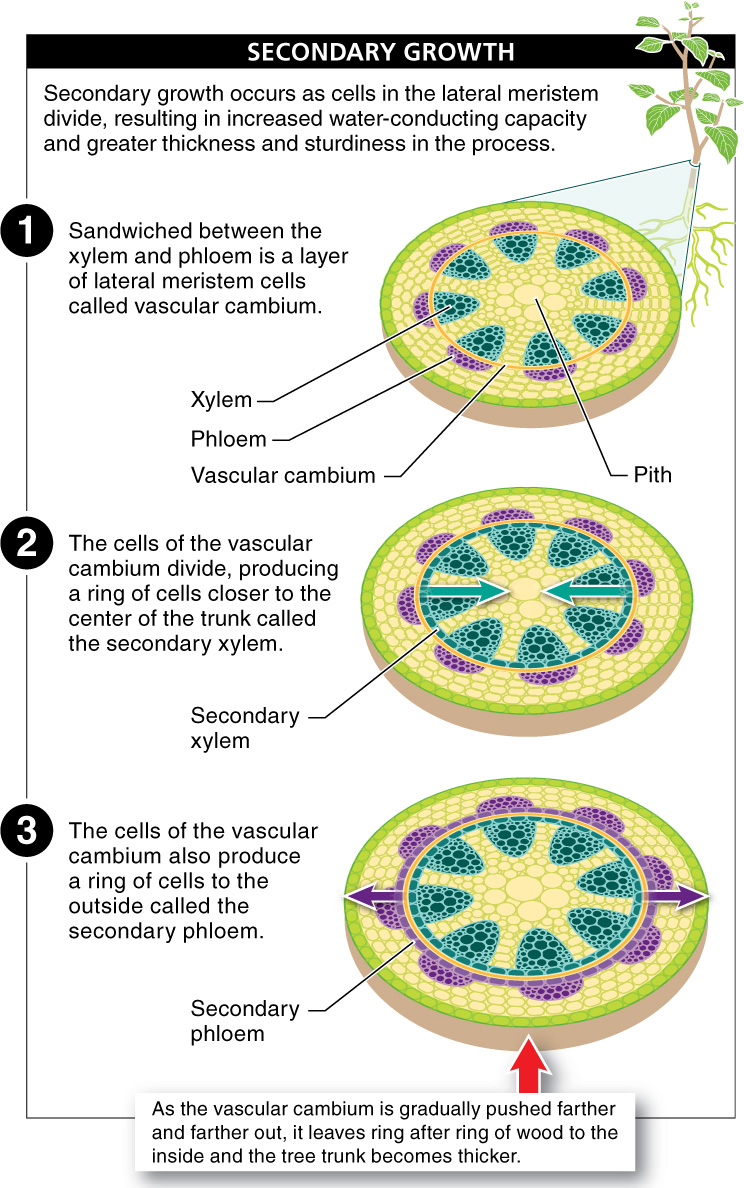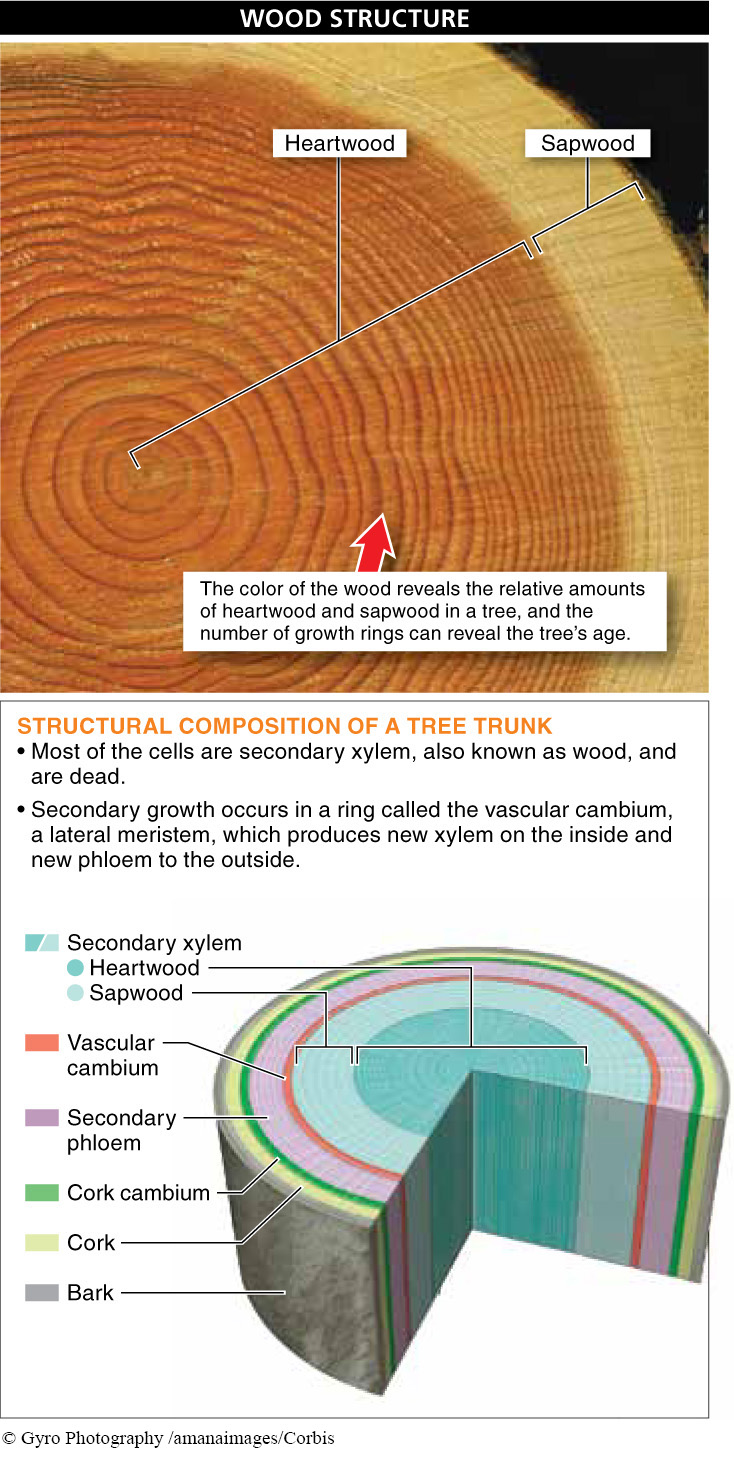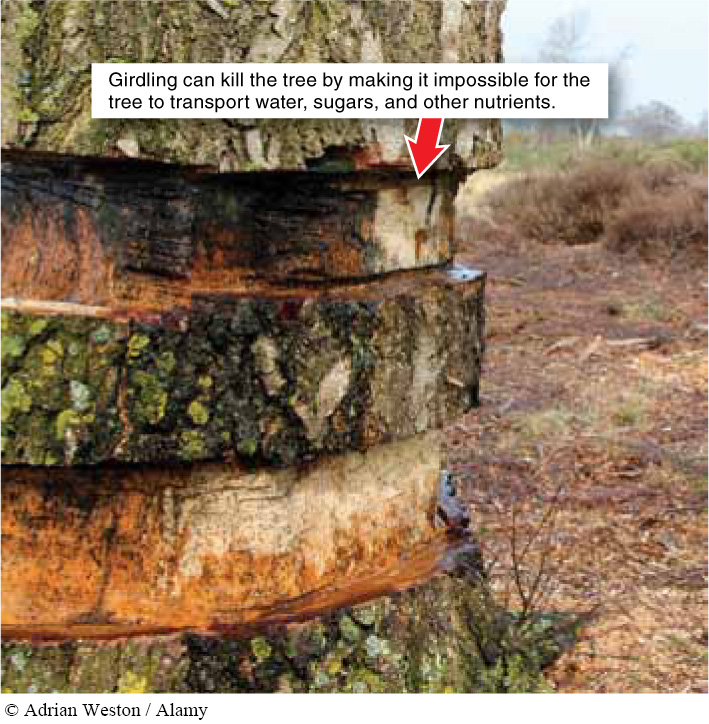

Wood is amazing. And not just from an aesthetic or utilitarian perspective—
Once the apical meristems have moved past a location in a stem or trunk during primary growth, that part of the plant can no longer elongate or become taller. It can, however, grow outward and become thicker. Here we investigate the process of secondary growth by which eudicots and some other angiosperms produce wood, increasing their capacity for water conduction and becoming thicker and sturdier in the process.
How does secondary growth occur? Imagine a cross section of a young woody plant. It is packed with concentric cylinders, one inside another, progressing outward from the center (FIGURE 18-32). First, from the center to about halfway to the outer circumference, extends the pith, soft spongy parenchyma cells. Just beyond the pith is a thin cylinder of vascular tissue: the xylem. A bit farther out is another cylinder of vascular tissue: the phloem. And beyond that is the epidermis and outer covering of the trunk. Sandwiched between the xylem and phloem lies the vascular cambium—a layer of lateral meristem cells. Recall that meristems contain perpetually youthful cells that can repeatedly divide and develop into any type of plant tissue.
As the cells of the vascular cambium divide, they produce two rings of cells—
Although most xylem initially acts like a long pipe through which water can pass, older xylem is like a clogged artery through which less and less blood can flow. Because the clogging of xylem is a progressive condition, the older the xylem, the more likely it is to be clogged. And the closer it is toward the center of the trunk, the older the xylem is. The clogged xylem is called “heartwood” and is darker, due to the accumulated resins and other non-
754
Why can you tell a tree’s age by counting its rings?
Looking at a cross section of a tree, we find that the color of the wood reveals the relative amounts of heartwood and sapwood. It can also reveal the age of the tree, in the growth rings. In temperate climates, more growth—
As the vascular cambium increases the girth of a tree and is pushed farther and farther out, the epidermal cells that make up the bark continuously split and fall from the tree. This tissue is replaced by the cork cambium—a cylinder of lateral meristem cells close to the outer edge of the trunk. The cork cambium plays an important role in the perpetual task of maintaining the protective covering of bark. As its cells divide, they produce a cylinder of waxy cork cells on the outside, a layer of cells that protects the outer surface of the trunk from water loss, fire, and infection by microbes. Secondary phloem, too, is pushed toward the outer surface of the trunk and eventually is sloughed off. For this reason, at any given time, although there may be a huge amount of functioning xylem, there is only a very thin layer of functioning phloem, and it is very close to the outer surface of the trunk. Often, only the phloem produced within the past year is still actively conducting sugars throughout the plant.
If you thoughtlessly carved your initials in the trunk of a tree 4 feet above the ground and came back in 10 years, would your initials be at the same height or higher? Why? What if you came back in 20 years?
Secondary growth increases the girth of a tree but doesn’t elongate it. So if you were to carve your initials in the trunk of a tree, the section below your initials would never increase in height. Moreover, because increases in girth can cause the outer layers of bark and epidermis to fall off, replaced by new cells pushing outward, your initials would eventually completely disappear from the tree trunk.
Bumping into a tree repeatedly with a lawn mower or “weed whacker” can kill the tree. Why?
An action that damages the bark of a tree all the way around its circumference is called “girdling.” It is possible to girdle a tree by accident with a “weed whacker” or a lawn mower. Girdling can actually kill a tree, even if the tree is very thick and the damage is not particularly deep. Because the phloem and vascular cambium layers are so close to the outer edge of the trunk, relatively shallow injuries to the trunk can destroy the secondary phloem and, if the damage goes just a bit deeper, the cells that give rise to new phloem.
755
When such damage occurs, the tree is still able to transport water from the roots to all of the tissues, because the xylem is much closer to the center of the trunk and isn’t damaged. But damage to the phloem makes it impossible for the tree to transport sugars and other nutrients from the sites of photosynthesis down to the roots where they are needed and stored. Shortly after the damage occurs, the tree may die (FIGURE 18-34).


Roots can be girdled, too. This kind of girdling can happen when trees are planted with wire or mesh netting around their roots. As the roots grow in girth, the metal or nylon can gradually destroy the vascular cambium as the roots grow outward, killing the tree about 5–
It is an odd fact about plants, especially trees, that most of the cells are dead. Remember (from Section 17-
TAKE-HOME MESSAGE 18.16
Secondary growth results from cell divisions in a thin cylinder of tissue between the primary xylem and the primary phloem—
What is the vascular cambium of a tree, and what is its function?
The vascular cambium is a ring of lateral meristem cells, situated between the xylem and the phloem and located fairly near the outer edge of the tree's trunk. When the cells of the vascular cambium divide, they produce a ring of secondary xylem cells, closer to the center of the trunk. The cells of the vascular cambium also produce a ring of secondary phloem cells, closer to the outside of the trunk. Through the division of the meristem cells of the vascular cambium, the girth of the tree is increased.
756